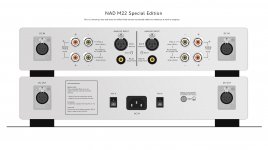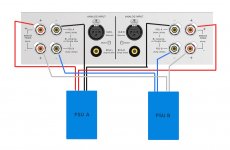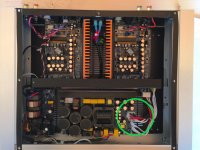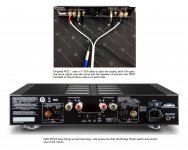I am by no means smarter or understand electronics better than the people at NAD or Hypex and just want to say thanks to all the engineers who worked on this project. As I say that I realize that there probably was some compromises done and the over all project goal had financial limitations in order to wrap the product in a package that did not risked costing to much. For me, things are a bit different since I basically will only pay for the components and not the brand or other engineers salary, neither do I consider myself to be wealthy but am able to invest that which is required. So with that out of the way, lets look at what the goals are.- Disclaimer -
This is by no means going to be a commercial endeavor, its a one mans personal journey in building an awesome class D amplifier. I do not own any rights to any idea presented or forwarded in this project and or on diyaudio.com thread created around this project. I understand that what is presented, asked about and debated in this thread is not suited for everyone which is fine. If you don't like the idea or general approach you are free to leave. While replication for personal use is frowned upon it is not considered illegal as long as it is for non-commercial use and without the intent to make money on it. This thread is not intended to be a guide on how to build or replicate a NAD M22 of your own but is more intended to be a build log and an endeavor in improving upon that which already exist, as well as achieving my personal goals.
- The primary goal of this project is to use 2 x NC400 amp modules per channel (4 x NC400 in total) achieving 2 x 250W + 2 x 250W and 2 x 900W - a total of 3 different modes: Single, true Bi-amping and Bridge/Mono mode.
- I will use 2 x PSU units called PSU A and PSU B. They are connected in such a way that they individually power a row of outputs (2 x 250W) or be used in Bridge/Mono mode so that each PSU power 1 chn.
- The amp and PSU modules will use individual chassis.
- A side mission is to look over all components used and improve/replace when and if needed. Such replacement can simply be to get rid of all electrolytic capacitors and get an overall improved individual component performance.
- NAD & Hypex schematics and values will stay intact, the only thing that changes is PCB layout and component type (manufacture and model).
To get things going, here is the attachment of the very first rendition of the backside of the amplifier (since that is the most existing thing right now.)
- Oneminde
Attachments
Last edited:
They have a nice working front-end (input), clipping protection and not sure if its NAD or Hypex, but there is feed-forward error correction besides negative feedback and they have the SMPS. Schematic are available and this present the least amount of hassle for me. One important aspect here is that its working and its a nice starting point. Why I simply don't buy stand alone NC400 modules is that I want to be free to chose components and get rid of electrolytic all together.
Right someone has finally steeped up and put some life on the class d forum instead of falling back to secret transmissions of publicly accessible information. All the skilled people are gone and journeyed into creating commercial products so us non-commercial gentlemen are free to do as please.
Are you building the NCORE amplifiers from scratch ? I'm more interested in that part, and would have started a similar thread but I have no time to invest in such a journey.
Are you building the NCORE amplifiers from scratch ? I'm more interested in that part, and would have started a similar thread but I have no time to invest in such a journey.
Last edited:
Yes, NCORE from scratch. It will basically be a refined M22.Are you building the NCORE amplifiers from scratch ?
I have a big RO 4350 B panel which will be dedicated to this project (see image). As I mentioned, I am collecting / researching about which capacitors and resistors to use and I will present this work in a few weeks from now.
Attachments
Last edited:
If anyone questions the sanity of wanting an amp that can deliver 2 x 900W, to answer that question or get an idea of why it can be beneficial, I have already spent some time forwarding some info there. I initially started a build log over at htguide.com but decided to move it over to diyaudio instead. I will link to entry #7 which answer - to a degree - the watt needs of an amplifier. There is some useful follow up by member Juhazi which follows after my entry, so take a look at that as well.
NAD M22 Special Edition.
NAD M22 Special Edition.
I looked at Pascal which is used in the Mytek Brooklyn Amp, I looked at Benchmark AHB2 which is a collaboration between Benchmark and THX and I looked at Hypex NC400. While all of these are considered top contenders, there isn't much differentiating them. Interestingly, there are several users and reviewers who spite finding the AHB2 very quite (pitch black), many consider it to be inferior to the NC400 which M22 use. Also, since the only amp I can fully access in terms of schematic is the M22, that became an easy choice.Right someone has finally steeped up and put some life on the class d forum instead of falling back to secret transmissions of publicly accessible information. All the skilled people are gone and journeyed into creating commercial products so us non-commercial gentlemen are free to do as please.
.
Class D was first presented in 1958 and between 2011 (?) many class D was considered not good enough. Looking back at early ICEpower, it have not aged well, compared to NC400 which still today is considered more than good enough. I believe that NC400 can be ever so slightly improved by using better components. As I am writing this, I am still to properly investigate and cover the original component selections, but have no doubt that once I am done, there will be an improvement. I am also confident that this amp will survive at least a decade before we potentially will see a better class D.
Simulation files can be found here. thanks to analogspiceman, irs20957 for the analysis.
LTspice Ncore simulation
LTspice Ncore simulation
Thanks for the LTspice sim, but, I am not looking to simulate it as we know the circuit works. Before I go any further, why wasn't the real NC400 schematic presented in that thread ? ... yes, portions of it was as a teaser, meaning KaSD has the exact same stuff I do and could have just shown it in its entirety but didn't.
I see, well, I guess it is, but at the same time its a simple matter of spending a few minutes and using the right search-string on google and it will pop up. The taboo is perhaps one of the reasons I have not posted it, its sort of hidden in the disclaimer. What I will show is the PCB since does will be of my own creation and can be considered to be inspired by the original work. Inspired vs copy is a thin line, but technically they are not the exact same thing either.
I see, well, I guess it is, but at the same time its a simple matter of spending a few minutes and using the right search-string on google and it will pop up. The taboo is perhaps one of the reasons I have not posted it, its sort of hidden in the disclaimer. What I will show is the PCB since does will be of my own creation and can be considered to be inspired by the original work. Inspired vs copy is a thin line, but technically they are not the exact same thing either.
I strongly encourage you to go ahead, please don't be concerned about the discrete behavior of the other members, majority of those who are making educated analysis have real commercial products and have to watch themselves very carefully, the class-d forum at the moment is swamped with commercial threads marketing amplifier technology in excess of $500+ and eclipsing smaller threads, and as a result of this, its watering down the intent of the forum which is the diy nature of the forum.
For the last 9 months I've been spending more time viewing at threads dating back almost 10 years ago as a result of this commercial squatting and among other things lack of interesting content.
Where I'm from our economy is doing really bad, building is the only way, buying amplifier technology worth $500+ is a luxury which I don't have.
Last edited:
You are correct in that the class D section of the forum contain too much marketing. "Hey, look at this product and its features, yours for the low sum of $119.99." This issue is not isolated to the class D section, its spread throughout the forum. Commercial products or diy kits is a natural element and I do welcome the diy kit section of diyaudio.com, while I generally think that pure advertisement should be a fair bit more restricted or found only in that specific subdivision, I don't run the forum nor make its rules. Also on a side note, a commercial product that is not open source can hardly be classified as diy since basically its a finished product totally closed off from ever being tempered with.
Its a different story with the items found through the diyaudio store which is open source and at the same time is offered as a kit to does who want an easy life.
Let me ask you a personal question Reactance; Your interest in the M22se, what is in it for you, what do you envision for yourself ?
For me, the M22se is not an endeavor in the art of replicating, its refinement and making it ever so slightly better in terms of distortion and over all SQ. Knowing that the original M22 is a superior contender, I have no issues spending the extra money on components - and my "Achilles heel" is looking inside an amp, pre-amp, DAC or what have you and being met with care and passion in the layout, wiring and overall finish of the installation. I think that when done right, electronics can be seen as art and not just a practical thing.
***
PS: I might be forced to re-think how the bridge mode will work. I might end up forced to do use the same approach as used for the original. As of right now, I'm not sure using the positive line from two different PSU's will work. Looking at the schematic, the PSU have 1 set of V+ and V- coming out of it and it is split into 2 x V+ & V- respectively - see green circle. Using two PSU's compared to one might pose a problem, but I am unsure.
Reading the user manual for the M22V2, it states: "When in bridge mode, Connect the source to the Left input sockets only. Do not connect anything to the Right Input socket when Bridge Mode is selected." - which mean that the bridge mode switch, "duplicate" the left input and send it to the right channel, similarly what the Y-XLR cable does on the original M22.
- Oneminde -
Its a different story with the items found through the diyaudio store which is open source and at the same time is offered as a kit to does who want an easy life.
Let me ask you a personal question Reactance; Your interest in the M22se, what is in it for you, what do you envision for yourself ?
For me, the M22se is not an endeavor in the art of replicating, its refinement and making it ever so slightly better in terms of distortion and over all SQ. Knowing that the original M22 is a superior contender, I have no issues spending the extra money on components - and my "Achilles heel" is looking inside an amp, pre-amp, DAC or what have you and being met with care and passion in the layout, wiring and overall finish of the installation. I think that when done right, electronics can be seen as art and not just a practical thing.
***
PS: I might be forced to re-think how the bridge mode will work. I might end up forced to do use the same approach as used for the original. As of right now, I'm not sure using the positive line from two different PSU's will work. Looking at the schematic, the PSU have 1 set of V+ and V- coming out of it and it is split into 2 x V+ & V- respectively - see green circle. Using two PSU's compared to one might pose a problem, but I am unsure.
Reading the user manual for the M22V2, it states: "When in bridge mode, Connect the source to the Left input sockets only. Do not connect anything to the Right Input socket when Bridge Mode is selected." - which mean that the bridge mode switch, "duplicate" the left input and send it to the right channel, similarly what the Y-XLR cable does on the original M22.
- Oneminde -
Attachments
Let me ask you a personal question Reactance; Your interest in the M22se, what is in it for you, what do you envision for yourself ?
- Oneminde -
I have a slightly different goal, I've already started working on the following:
I'm just a bit busy so primary work is keeping me busy. this is what I have in mind.
- DIY SMPS, I'm busy working on one, not LLC but traditional Half Bridge for simplicity sake.
- Fully mico-controller based, I have sufficient firmware experience so amplifier protection and supervision can be shifted into a 32-bit micro.
- DSP controlled, Analog Devices has a very power platform for signal processing these days, I have access to SHARC dsp tools but an initial design using SHARC is overkill, I would use Sigma DSP for most of the front end logic.
- STM micro has acquired some key companies for developing slick UI's on larger LCD's (none of this 2x16 LCD's) see Touch GFX
- Multi channel amplifier.
For me majority of the fun is not actually amplifier design, its the micro-controller/DSP with code used to control sophisticated parameters and protections I think more added value is in this.
I see, you are doing the front end and control section of it all, got it. So the NC400 is then what you will use as the power amp in all of that ?
I will need a per-amplifier and there I am considering the UGS-muse preamp GB.
I will need a per-amplifier and there I am considering the UGS-muse preamp GB.
I see, you are doing the front end and control section of it all, got it. So the NC400 is then what you will use as the power amp in all of that ?
I will need a per-amplifier and there I am considering the UGS-muse preamp GB.
Correct, as soon as I get time to build a few..
Am I correct in assuming you have everything covered ?
Just an initial concept.
- Status
- Not open for further replies.
- Home
- Amplifiers
- Class D
- NAD M22 Special Edition.




